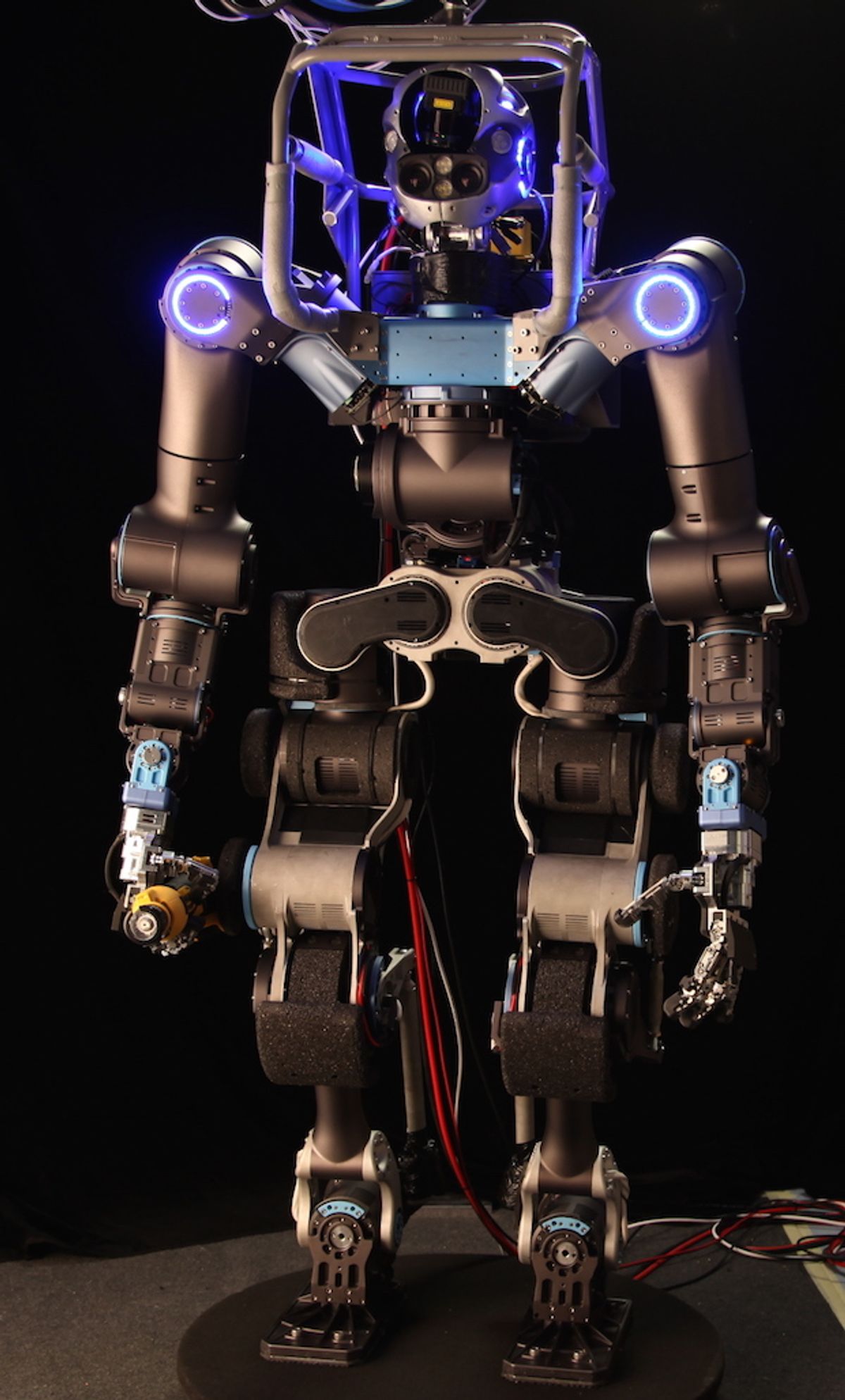While some DRC teams received fancy ATLAS robots from DARPA and other teams decided to adapt existing platforms (HUBO and HRP-2, for example) to compete in the Finals, some groups set out to build completely new robots. One of these is Team WALK-MAN from the Italian Institute of Technology (IIT), whose most recent robotic creations include HyQ and COMAN. Before departing to the DRC Finals site in Pomona, Calif., Nikos Tsagarakis, a senior researcher at IIT and WALK-MAN Project Coordinator, spoke with us about his team’s highly customized robot, its mains capabilities, and how it compares to ATLAS.
To design and build WALK-MAN, did you get inspiration from other robots? Which ones?
WALK-MAN was developed as part of the European Commission-funded Project WALK-MAN, and the goal was creating a completely original and new body design, so it is different from any other existing robot we developed so far at IIT. Apart from following our traditional approach to soft robot design by adding joint elasticity to the robot’s joints, WALK-MAN’s hardware is 100 percent new. Its main features include the use of custom designed high-power motor drives able to deliver several kilowatts of peak power at a single joint. We also optimized the design of its body to reduce the inertia and mass and improve the dynamic performance of the robot. A rich sensory system gives us the state of the robot in terms of loads (joint torque sensing) and thermal sensing/fatigue for both the actuators and the electronics. In terms of control, WALK-MAN drives can be controlled in different modes including position, torque, and impedance at rates up to 5 kHz.

How does WALK-MAN compare to ATLAS?
The two robots differ in their actuation system (WALK-MAN is an electrical motor driven robot while ATLAS is a hydraulic system) but are very similar in certain dimensions like height (1.85 m) and shoulder distance (0.8 m). WALK-MAN is lighter (120 kg with backpack) than Atlas (around 180 kg). In terms of capabilities, WALK-MAN joint performance is very close to ATLAS joints. Leg joints can produce torques up to 320 Nm and reach velocities of 11 to 12 radians per second at torques as high as 250 Nm. WALK-MAN arms have more extensive range and can generate torques up to 140 Nm at the shoulder level. We also expect to be a more efficient robot than ATLAS and able to operate for more prolonged periods without recharging.
What about the software that powers the robot? What can it do autonomously?
The software architecture is based on ROS and YARP. Various software components of the robot use ROS modules while the software interface of the robot is based on the YARP middleware developed at IIT. The robot is commanded by a human operator from a pilot station and can perform autonomously some tasks such as balancing, walking, and distance measurements using its perception system. The majority of the robot actions are driven by the commands provided by the operator, who is responsible for all the decisions and actions required during the remotely executed tasks. We set up a special training area in the lab, in order to construct the mockup of several tasks of the DRC probable arena: a wall to be cut, a door to open and pass through, a valve and a long corridor to walk. We also practiced the driving task using the Polaris car inside the IIT parking lot.

What has been the biggest challenge so far?
The biggest challenge has been the available time for us: WALK-MAN Project started 15 months after the introduction of the DRC, around the time of the DRC Trials in December of 2013. We had to build an entire new platform while at the same time develop our software in simulation. WALK-MAN was designed and fabricated within a record time of 10 months (from March 2014 to January 2015). We then had to debug our new hardware and integrate and debug the high level software and eventually make the system reliable so we could do experiments and perform tasks. We had only three months before the DRC Finals to do all that and it was certainly a very big challenge given the complete new set of customized components we used.

How many people do you have in the team?
The team consists of 19 people, mostly PhDs, master’s students, and postdoc researchers. The development of the robot software was done by 12 people who are working on the low level firmware, the software architecture, the high level motion generation and perception modules, and the operator station software. The robot hardware group consists of seven people with five of them dedicated to the mechanical design of the system and two on the customized electronics of the robot. The team is mostly from IIT, with 13 people working full time on the project, but we also have collaborators from Centro E. Piaggio and from the group of Prof Antonio Bicchi at the University of Pisa.
[ WALK-MAN Project ]
Erico Guizzo is the director of digital innovation at IEEE Spectrum, and cofounder of the IEEE Robots Guide, an award-winning interactive site about robotics. He oversees the operation, integration, and new feature development for all digital properties and platforms, including the Spectrum website, newsletters, CMS, editorial workflow systems, and analytics and AI tools. An IEEE Member, he is an electrical engineer by training and has a master’s degree in science writing from MIT.
Evan Ackerman is a senior editor at IEEE Spectrum. Since 2007, he has written over 6,000 articles on robotics and technology. He has a degree in Martian geology and is excellent at playing bagpipes.



